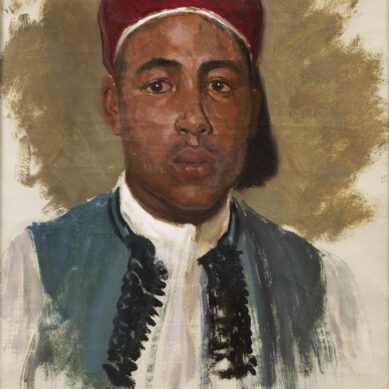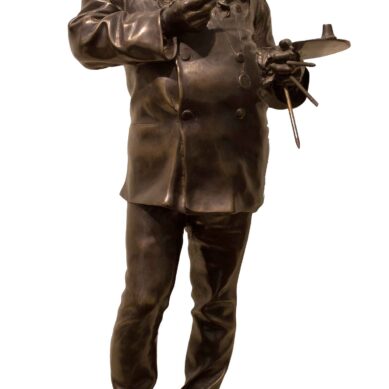You searched
Sculptor
Herta Ottolenghi Wedekind
Are you interested in the sales or the purchase of his artworks?
We buy works of this artist
and of other painters and sculptors from the 16th century to the first half of the 20th century
The Berardi gallery offers a free and without obligation service for evaluation of ancient and modern art . To find your way in the art market, very complex and full of nuances, it is better to rely on a professional consultant who can answer fast and concretely to your needs. The clarity of the answers will resolve effectively the need to estimate or sell an asset.
Contact us immediately without commitment
Answers also in 24 hours:
Herta Ottolenghi Wedekind
Herta Ottolenghi Wedekind
Herta Ottolenghi Wedekind was born in Berlin in 1885. She is the daughter of Sophie Danzier and Paul Wedekind zu Horst. A long-standing family of German nobility, the Wedekinds, bankers and entrepreneurs, have a Sicilian branch since Paul’s generation.
The renowned Wedekind bank has a branch in Palermo and one in Rome, in the Palazzo delle Poste Pontificie in Piazza Colonna, later the editorial office of ‘Il Tempo’. This prestigious residence was also Herta’s home during her youthful stays in Rome. Her grandfather Karl, a generous and refined patron of the arts, had commissioned Arnold Böcklin to decorate his house in Hannover with frescoes in 1858. Growing up in a rich and stimulating cultural environment, Herta soon followed her artistic inclination, a destiny shared with her sister Jula, who was to establish herself as a photographer.
Training in Rome at Hans Stoltenberg Lerche’s studio
After a cosmopolitan education in Berlin, Munich, Hanover, Palermo and Rome, Herta chose to settle in Rome between 1910 and 1912 in order to develop her talent for sculpture. Here she was a pupil of the German sculptor and ceramist Hans Stoltenberg Lerche, in his prestigious studio in Via Flaminia.
On her return to Germany, she met Arturo Benvenuto Ottolenghi. Coming from a wealthy Jewish family from Piedmont, he had travelled to Munich and Hanover to extend and complete his law studies. Herta and Arturo were married in Rome in 1914 and lived there until 1920, in a flat at 35 Via Giovanni Battista Morgagni. Herta set up her studio there, where she produced a number of sketches in terracotta and plaster, which were later translated into stone and bronze. In February 1917, Herta and Arturo’s only son, Astolfo, was born in Rome.
Herta’s time in Rome alternated with several stays in a sanatorium in Davos, Switzerland, to treat tuberculosis. In this secluded and elitist place, she continued to devote herself to sculpture. In addition, she began to develop the idea of a particular and original procedure for preparing images and designs for textiles, which would soon become popular and to which she would devote herself throughout the 1920s.
The 1920s: embroidered fabrics and the golden age of H.O.W. at decorative art exhibitions
With Arturo he moved to Liguria to get closer to the Ottolenghi family who lived in Genoa. They settle in the Art Nouveau villa Ceriana Mayneri in Pieve di Sori on the Riviera di Levante. It was here that their plans for the renovation of the Monterosso property in Acqui Terme began to take shape, a total work of art in which they would welcome the work of painters, architects, sculptors and craftsmen, in a sort of workshop of the arts based on the Renaissance model. This was the period of the Ottolenghi family’s great patronage of the arts until the 1940s.
On 24 January 1922, in Turin, Herta patented the process she had developed, which was essentially based on kleksographs produced on squared paper, so that they could be easily transferred onto fabrics and textiles. In the same year, he took part in his first exhibition, the German Fair of Munich (Deutsche Gewerbeschau München) with his hand-embroidered carpets, cushions and chairs.
In 1923, he took part in his first Italian exhibition, the 1st International Exhibition of Decorative Arts in Monza. He had his own room on the first piano nobile where he presented tapestries, blankets, carpets, screens, chairs and fabrics. He won a gold and a silver medal and two of the tapestries exhibited were bought by the City of Milan. His creativity in the field of applied arts immediately attracted the attention and praise of Guido Marangoni, president of the Monza exhibition, who reviewed his fabrics in several articles. This was followed by his appearances at all the Monza exhibitions until 1930. In the meantime, the project for the villa in Monterosso finally took off.
The project for Villa Ottolenghi in Acqui Terme
In 1924, Herta and Arturo visited the 2nd Rome Biennale at the Palazzo delle Esposizioni where they met Ferruccio Ferrazzi and bought his Adolescent. The idea of the Villa di Monterosso in Acqui Terme becomes more and more a reality, thanks to the involvement of Ferruccio Ferrazzi, who is called in to manage the iconographic and artistic programme of the Villa. Shortly afterwards, he also painted the Portrait of Herta Ottolenghi with her son Astolfo.
In 1925, Herta was present at the Exposition internationale des arts décoratifs et industriels modernes in Paris in the Section italienne of the Grand Palais, where she was awarded a diploma of honour and a gold medal.
In 1930, she also took part in the 1st Women’s Exhibition of Art and Work at the Castello Sforzesco in Milan with embroidered panels, tapestries and carpets. She was awarded the Vermeille medal. At the Triennale, the couple bought many ceramics by Arturo Martini, whom they involved in the decoration of the Villa di Acqui, together with Ferrazzi (who was mainly involved in the mausoleum) and several other artists.
It was in the 1930s that the Ottolenghi’s enlightened patronage reached its peak, involving, in addition to the artists already mentioned, Venanzo Crocetti, Marcello Piacentini and Libero Andreotti.
After having definitively abandoned the design and production of textiles, Herta fully resumed her sculptural activity, which was particularly appreciated by Martini, as can be seen from her correspondence with Arturo Ottolenghi. Many of her works date back to this period and are included not only in the collection of the villa, but also and above all in the plastic decoration of the Ottolenghi hospice in Acqui. In the 1940s, the war slowed down the work at Monterosso. Although Arturo belonged to a Jewish family that had already converted to Catholicism in the previous generation, he suffered the confiscation of all his property, the freezing of all his bank accounts and was arrested and then released in 1945.
In 1947, the Ottolenghi couple joined their son Astolfo in America. On this occasion, Herta donated two tapestries that she had brought with her from Italy to the Metropolitan Museum in New York and they were displayed in the ‘Textile Study Room’.
In 1951, her husband Arturo died. Two years later, Herta died in Acqui Terme. Her son Astolfo, involving other artists and architects, completed his parents’ project at the beginning of the 1960s, adding a large garden to the villa and mausoleum.
Elena Lago











